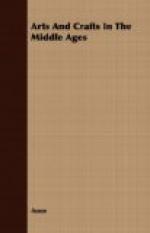St. Anthony appears on a little sculptured medallion on the tomb of Henry VII., with a small pig trotting beside him. This is St. Anthony of Vienna, not of Padua. His legend is as follows. In an old document, Newcourt’s Repertorium, it is related that “the monks of St. Anthony with their importunate begging, contrary to the example of St. Anthony, are so troublesome, as, if men give them nothing, they will presently threaten them with St. Anthony’s fire; so that many simple people, out of fear or blind zeal, every year use to bestow on them a fat pig, or porker, which they have ordinarily painted in their pictures of St. Anthony, whereby they may procure their good will and their prayers, and be secure from their menaces.”
Torregiano’s contract read that he should “make well, surely, cleanly, and workmanlike, curiously, and substantially” the marble tomb with “images, beasts, and other things, of copper, gilte.” Another craftsman who exercised his skill in this chapel was Lawrence Imber, image maker, and in 1500 the names of John Hudd, sculptor, and Nicolas Delphyn, occur. Some of the figures and statuettes on the tomb were also made by Drawswerd of York.
On the outer ribs of Henry VII.’s chapel may be detected certain little symmetrically disposed bosses, which at first glance one would suppose to be inconspicuous crockets. But in an admirable spirit of humour, the sculptor has here carved a series of griffins, in procession, holding on for dear life, in the attitudes of children sliding down the banisters. They are delightfully animated and amusing.
The well-known figures of the Vices which stand around the quadrangle at Magdalen College, Oxford, are interpreted by an old Latin manuscript in the college. The statues should properly be known as the Virtues and Vices, for some of them represent such moral qualities as Vigilance, Sobriety, and Affection. It is indeed a shock to learn from this presumably authoritative source, that the entertaining figure of a patient nondescript animal, upon whose back a small reptile clings, is not intended to typify “back biting,” but is intended for a “hippopotamus, or river-horse, carrying his young one upon his shoulders; this is the emblem of a good tutor, or fellow of the college, who is set to watch over the youth.” But a large number of the statues are devoted to the Vices, which generally explain themselves.
[Illustration: GROTESQUE FROM OXFORD, POPULARLY KNOWN AS “THE BACKBITER”]
No more spirited semi-secular carvings are to be seen in England than the delightful row of the “Beverly Minstrels.” They stand on brackets round a column in St. Mary’s Church, Beverly, and are exhibited as singing and playing on musical instruments. They were probably carved and presented by the Minstrels or Waits, themselves, or at any rate at their expense, for an angel near by holds a tablet inscribed: “This pyllor made the meynstyrls.” These “waits” were quite an institution, being a kind of police to go about day and night and inspect the precincts, announcing break of day by blowing a horn, and calling the workmen together by a similar signal. The figures are of about the period of Henry VII.




